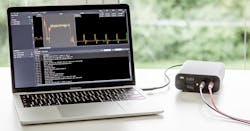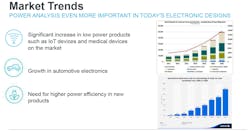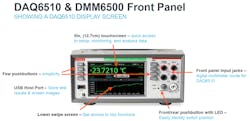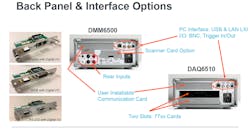These Test Advances Simplify IoT Device Energy Optimization
Now and again, a piece of test equipment comes along that makes you go, “Huh, hang on a sec’, that’s pretty useful.” That’s not to say the new WaveSurfer 3000z ‘scope from Teledyne LeCroy or the even newer DMM6500 and DAQ6510 digital multimeter, data-acquisition, and logging systems from Keithley/Tektronix aren’t also useful. It’s just that the Otii Arc from Qoitech provides a new approach to the problem of energy optimization when testing IoT devices.
Energy efficiency is always good, but particularly when a device is battery-operated, so designers must ensure they have optimized every aspect of a design for low power consumption. During the development stage, this typically means hooking a breadboard or development kit up to a power supply and using various techniques, such as a current shunt with a ‘scope or a multimeter, to measure current flow directly.
However, this involves multiple pieces of equipment and often the resolution of a scope won’t catch fast spikes. Ditto for a digital multimeter (DMM). Also, the DMM at hand may not be able to measure down to the microamp or nanoamp range. This current level is where these portable loT devices, e.g., remote sensors or health monitors, are headed. Much depends on the equipment at hand, your budget for new equipment, and the software available to do dedicated energy monitoring.
1. The Otii Arc from Qoitech combines a power supply and energy monitor in a single box for IoT device prototyping, using a USB to hook up to a PC running Windows, Ubuntu, or MacOS. (Source: Qoitech)
That’s what’s interesting about Qoitech’s Otii Arc (Fig. 1). Specially designed to optimize energy consumption in IoT devices during the development stages, it combines a power supply and energy monitor in one small, fanless box. It connects to a PC (Windows, MacOS, or Ubuntu) over a USB cable after hook-up; the accompanying software takes it from there.
With minimal setup, you can be looking at the energy consumption of a prototype within minutes. The system is priced at $699, but if you buy before the end of May, you can get it for $469. This includes the software. However, for an extra annual license fee, extra features and premium tech support are added into the mix.
I’m actually so excited about the Otii Arc that I’m going to tear it down at DAC 2018 in a few weeks (June 24-28). We'll get into what Qoitech did and how it did it. Join me at the teardown: I’ll even be giving away a new Arc Otii (as in, not torn down).
Advanced DMMs, DAQs, and Scope Updates Abound
As novel, interesting, and inexpensive as the Qoitech may be, Tektronix (Keithley division) has made interesting updates to its DMM and DAQ line, with an eye toward simplicity and accelerating test time.
In the case of the new 6-1/2-digit bench/system DMM6500, it’s also aimed at solving bench-level low-power test issues, typical of IoT devices. As Bob Green, senior market development manager at Tektronix put it, power analysis is becoming increasingly important in low-power medical products, as well as automotive electronics, and more power-efficient new products (Fig. 2).
2. Power analysis is increasingly important for the growing worldwide IoT market (top, showing 50 billion by 2025) as well as automotive electronics, which will be 50% of the cost of a car by 2030. (Source: Tektronix)
Using numbers from various studies, Green predicts upwards of 50 billion internet-connected devices by 2025 and that electronics will be 50% of the cost of a car by 2030. With these trends come the need to measure into the hundreds of nanoamps, the ability to capture more complex load currents generated by wireless devices, and ever-increasing time-to-market pressure. Not to mention lower cost per device, making efficient test even more critical.
Along the same vein, when it comes to manufacturing test, it’s critical to move from test to test, quickly, have fewer test stations, get ready access to data and view it clearly, and conduct deeper analysis. That’s the purpose of the DAQ6510 data-acquisition and logging multimeter system.
3. The DAQ6510 and DMM6500 share the same uncluttered front panel with a 5-in. touchscreen interface. (Source: Tektronix)
Both the DMM6500 and the DAQ6510 come with Kickstart 2.0 software, 5-in. touchscreens, fewer buttons for an uncluttered feel, greater data visibility and graphing capability, as well as quick “pinch and zoom” for closer analysis (Fig. 3).
The DMM6500, which can store up to 7 million readings, emulates the Keithley model 2000 6-1/2-digital DMM and the Keysight 34401A 6-1/2-digit DMM. If more than one channel is needed, an optional 10-channel scan card or a 9-channel temperature card can be plugged into the rear (Fig. 4).
4. Back-panel options vary for the DMM6500 and DAQ6510. (Source: Tektronix)
For test engineers on the manufacturing line, the quick-to-set-up DAQ6510 can scan at 800 channels/s with a solid-state switch card. It’s able to plot up to 20 channels on one graph and perform statistical analysis.
The DMM6500 and DAQ6510 are both compatible with Keithley’s test script (TSP) software, which allows it to execute a test with minimal intervention from a PC. To see the DAQ6510 in operation, Tektronix developed a video of how to set it up for a temperature scan of a device under test under different environmental conditions:
Price-wise, the DMM6500 is $1,140, while the DAQ6510 goes for $1,750, MSRP.
On the scope side of things, Teledyne LeCroy used the recent ESC show in Boston to showcase its updated its WaveSurfer 3000z scope. The new model gets a bandwidth of 100 MHz while also incorporating all the bells and whistles of the WaveSurfer 3000 model, but “at an entry-level price.”
The scopes have a 10.1-in. capacitive touchscreen and comes in five models, from 100 MHz to 1 GHz, with sample rates up to 4 Gsamples/s. Pricing starts at $3,450 for the 100-MHz 3014z, all the way up to $9,950 for the 1-GHz 3104z.





